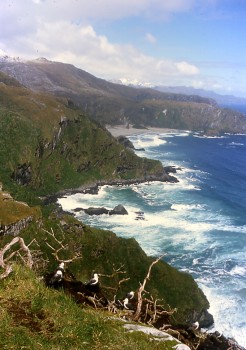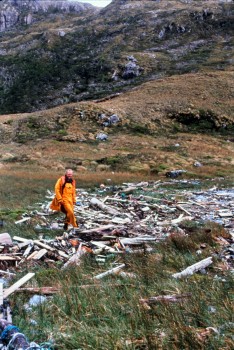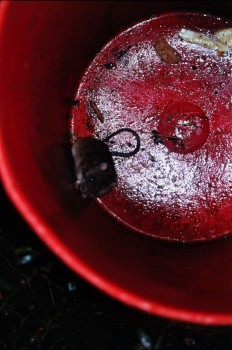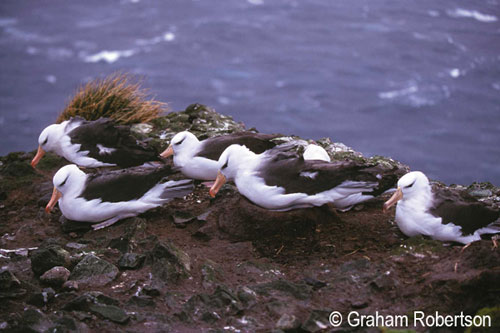The Pink-footed Shearwater Puffinus creatopus is a Chilean endemic with only three known breeding sites, Isla Mocha and two islands, Robinson Crusoe and Santa Clara, in the Juan Fernández Archipelago. Chile has proposed its listing within the Albatross and Petrel Agreement (click here)
The species is listed in Appendix 1 of the Bonn Convention on Migratory Species (CMS), as Threatened by Canada and as a Species of Common Conservation Concern by the tri-national Commission for Environmental Cooperation (CEC).
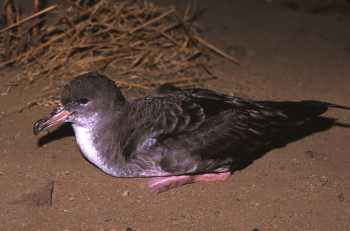
A Pink-footed Shearwater in a breeding colony on Isla Mocha
Isla Mocha, with an estimated 19 000 breeding pairs, possesses the largest known breeding population. The 4800-ha island is comprised of a low-lying coastal plain that encircles the rugged, forested hills of the interior. The central highlands of the island are protected as a Chilean National Reserve. The Pink-footed Shearwater is the only seabird species that currently breeds on Isla Mocha.
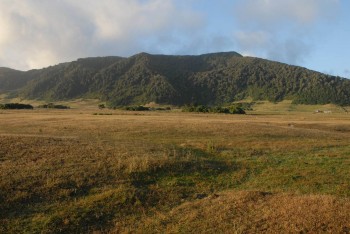
The forested ridges in the centre of Isla Mocha comprise the reserve in which the Pink-footed Shearwater colonies are located
On Isla Mocha, the breeding colonies are located in native forest. To arrive at their burrows, birds crash through the canopy and plummet to the forest floor. In order to depart, shearwaters climb trees to reach take-off platforms on branches in the upper canopy. The principal threats to birds in the colonies are predation by feral cats Felis catus and the occasional domestic dog and the human exploitation of chicks that has been greatly reduced with recent enforcement of a ban on such activity. At sea, there is evidence of bycatch in both artisanal and commercial fisheries.
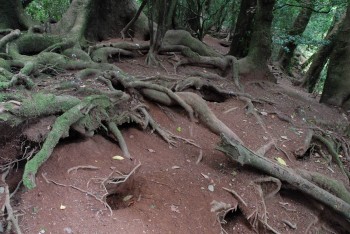
Typical Pink-footed Shearwater breeding habitat on Isla Mocha, with burrow entrances amongst tree roots
Pink-footed Shearwaters also breed on two islands in the Juan Fernández Archipelago, Isla Santa Clara (c. 3800 pairs) and Isla Robinson Crusoe (c. 5100 pairs). The islands are also the only breeding location for Juan Fernández Pterodroma externa, Stejneger’s P. longirostris and De Filippi’s P. defilippiana Petrels.
Isla Santa Clara, approximately 220 ha in area, lies two kilometres off the western tip of Isla Robinson Crusoe. After the successful eradication of European Rabbits Oryctolagus cuniculus in 2003 the island is now free of introduced mammals. The principal colony-based concern is the high rate of erosion in some of the colonies due to loss of native vegetation cover.

Isla Santa Clara from its summit. Small shearwater breeding colonies are scattered on various slopes throughout the island
The Vaquería breeding colony, with approximately 2100 breeding pairs, is the largest on Isla Robinson Crusoe. The colony extends along a ridge, with shearwaters nesting in both remnant patches of native forest as well as on open slopes. Historically, the area was impacted severely by clearing of forests and cattle grazing, although neither of these activities is permitted today. The major colony-based threat in Vaquería is predation by feral cats and, to a lesser extent, by the introduced Coatimundi Nasua nasua.
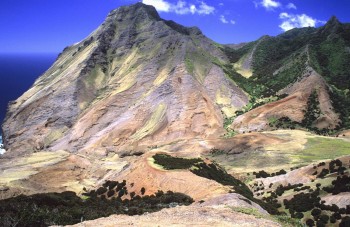
The Vaquería breeding colony on Isla Robinson Crusoe extends along the ridge that descends in the central foreground. Burrows are located primarily on the slopes that drop off the rounded ridge crest
The second-largest breeding colony on Isla Robinson Crusoe is Piedra Agujereada. Approximately 1100 breeding pairs use the colony, which suffers the highest predation rates by feral cats of all of the Robinson Crusoe colonies. In addition to predation, cattle grazing in the colony destabilized slopes and directly damaged burrows. In 2012, a fence was installed in the central part of the colony to exclude cattle.

The Piedra Agujereada breeding colony on Isla Robinson Crusoe is located on the upper half of this east-facing slope
Results from satellite-tracking studies indicate that during the breeding season shearwaters use a foraging hotspot in the Talcahuano region of Chile which is also the region with the greatest fisheries activity in the country. Tracking of their migratory routes has revealed that a significant proportion of post-breeding birds winter in Peruvian waters while others migrate up to California Current waters off the Pacific coast of North America.

The Pink-footed Shearwater is heavily dependent on continental shelf and shelf-break waters throughout its annual cycle
All photographs by Peter Hodum.
Selected References:
Commission for Environmental Cooperation 2005. North American Conservation Action Plan: Pink-footed Shearwater. Secretariat of the Commission for Environmental Cooperation. vii + 49 pp.
Committee on the Status of Endangered Wildlife in Canada 2004. COSEWIC Assessment and Status Report on the Pink-footed Shearwater . Ottawa: Committee on the Status of Endangered Wildlife in Canada. vii + 22 pp.
Cooper, J. & Baker, G.B. 2008. Identifying candidate species for inclusion within the Agreement on the Conservation of Albatrosses and Petrels. Marine Ornithology 36: 1-8.
Environment Canada 2008. Recovery strategy for the Short-tailed Albatross (Phoebastria albatrus) and the Pink-footed shearwater (Puffinus creatopus) in Canada. Species at Risk Act Recovery Strategy Series. Ottawa: Environment Canada. vii + 46 pp.
Gladics, A. & Hodum, P.J. 2010. Impactos a madrigueras de la fardela blanca (Puffinus creatopus) en colonias con y sin ganado, Isla Robinson Crusoe, Archipiélago Juan Fernández. Informe técnico para la Corporación Nacional Forestal (CONAF).
Hinojosa S.A. & Hodum, P.J. 2008. Plan nacional para la conservación de la fardela de vientre blanco Puffinus creatopus Coues, 1864 en Chile. Corporación Nacional Forestal (CONAF) and Comisión Nacional del Medio Ambiente (CONAMA), Chile. 34 pp.
Hodum, P.J. 2011. Monitoreo de la población reproductora de la Fardela Blanca (Puffinus creatopus) en Isla Santa Clara. Informe técnico para la Corporación Nacional Forestal (CONAF).
Hodum, P.J. 2007. Respuesta poblacional de la fardela blanca (Puffinus creatopus) de próximo de la erradicación de conejos europeos (Oryctolagus cuniculus) en Isla Santa Clara. Informe técnico para la Corporación Nacional Forestal (CONAF).
Peter Hodum, University of Puget Sound, Tacoma, Washington, USA, 2 January 2014
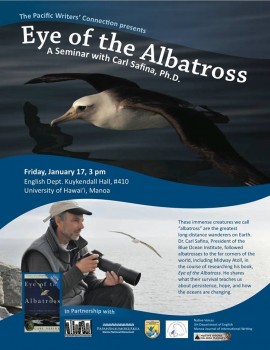

 English
English  Français
Français  Español
Español 